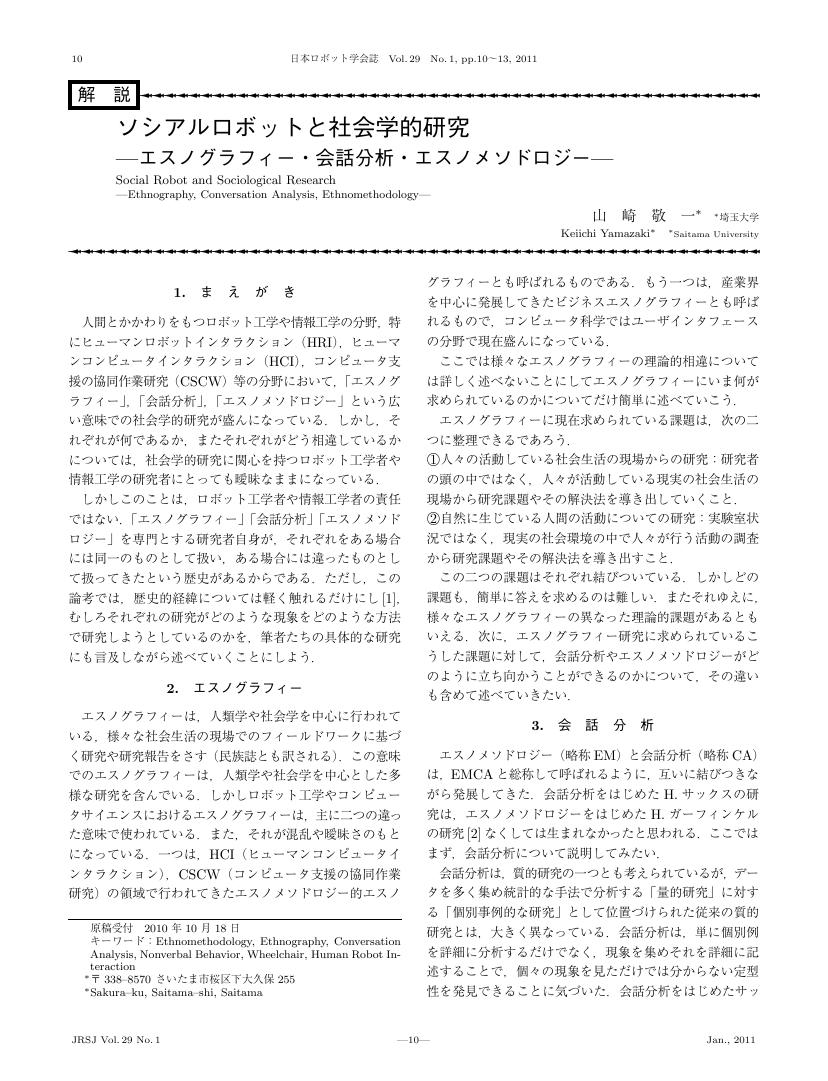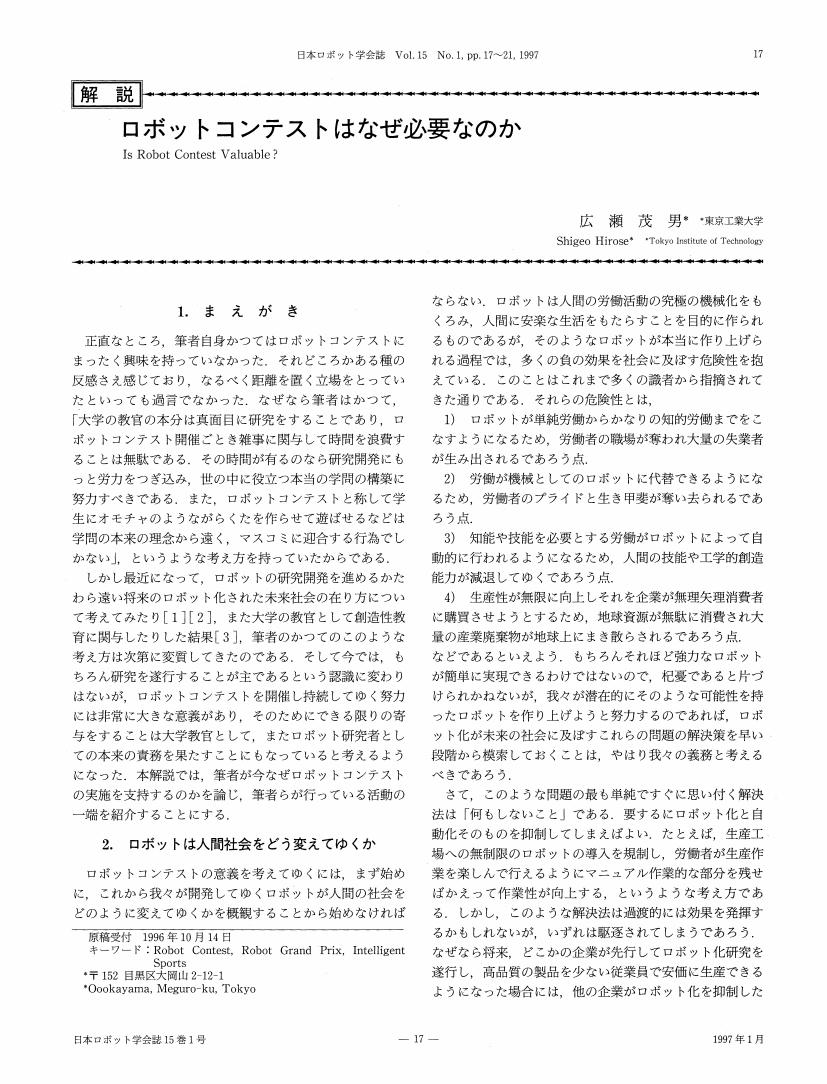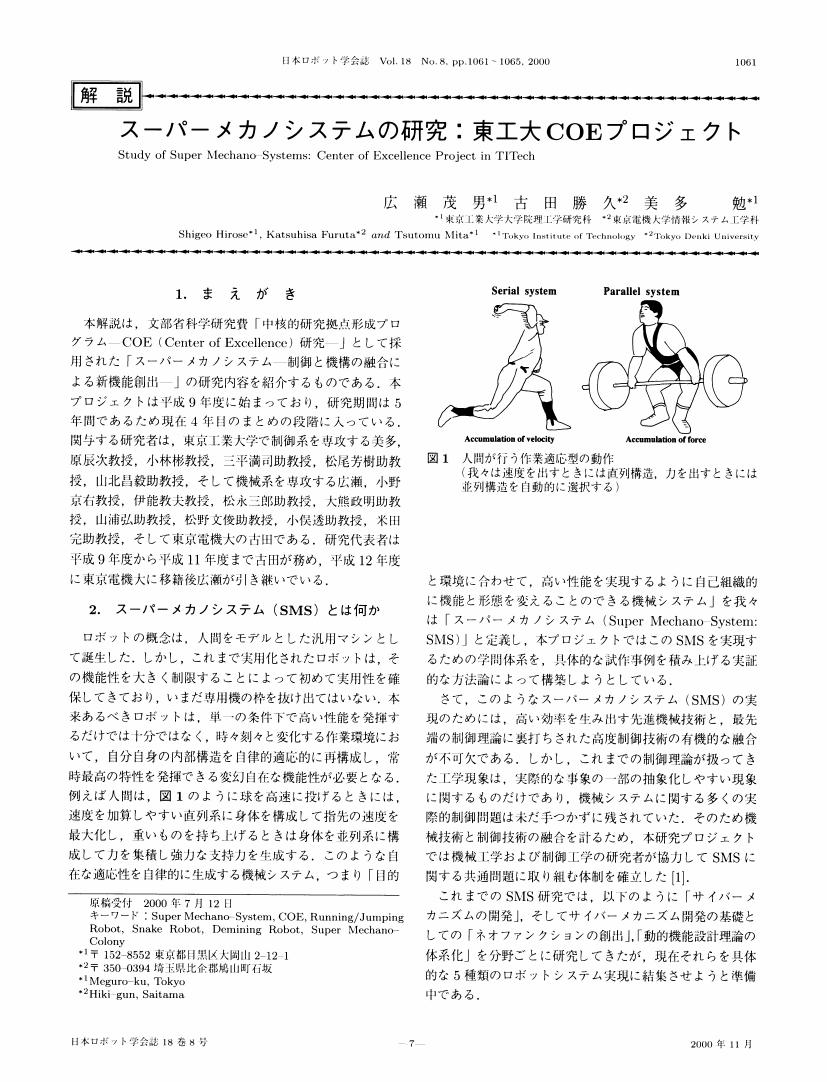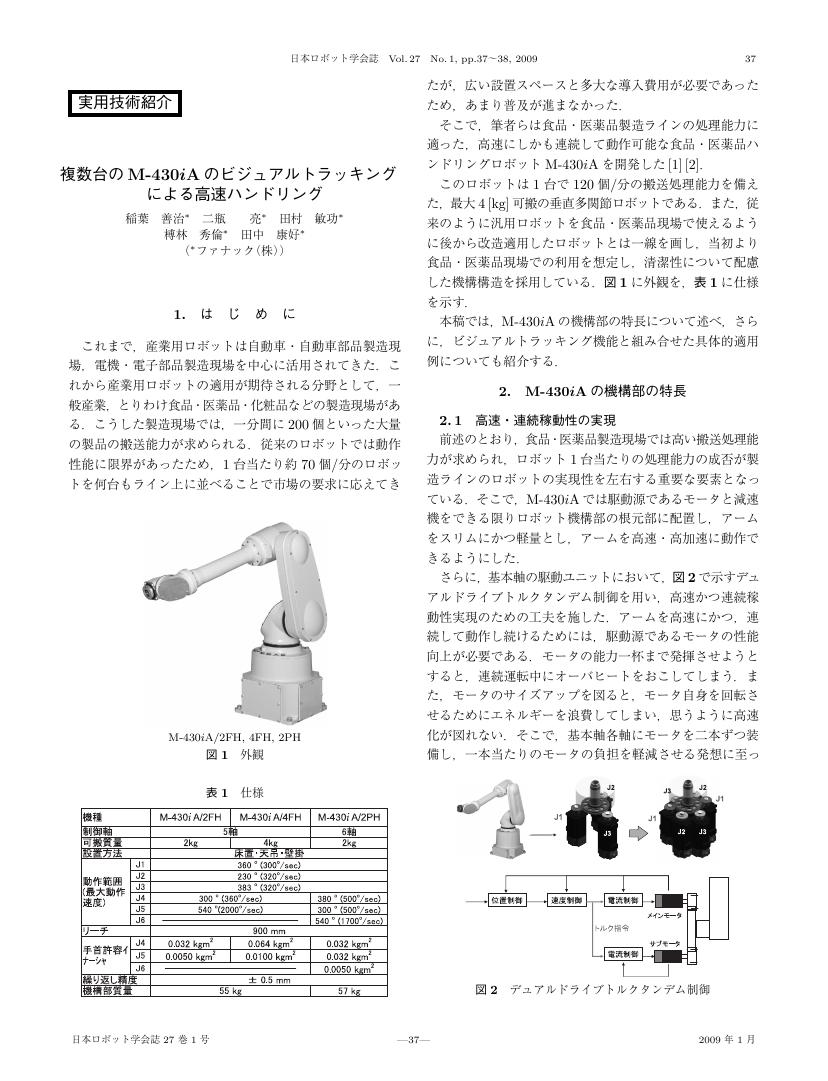- 著者
- 小林 一也 吉海 智晃 後藤 健文 稲葉 雅幸
- 出版者
- 一般社団法人 日本ロボット学会
- 雑誌
- 日本ロボット学会誌 (ISSN:02891824)
- 巻号頁・発行日
- vol.31, no.4, pp.416-423, 2013 (Released:2013-06-15)
- 参考文献数
- 11
- 被引用文献数
- 1
It is preferable that robots have soft outer cover and give themselves fewer impact in contact with humans or surroundings. Although self-protection is one of the most important functions and inevitably required for robust robot architecture, Simple introducing thick “flesh” to a robot tends to impede the movability and generality. In this paper, we have realized soft and thick outer cover by multilayered and distributed softness, and have introduced joint protection by dislocation and auto recover function. Finally, we realized various contact behaviors by the robot with distributed soft cover and joint dislocation ability.
1 0 0 0 OA 高速多指ハンドアームと高速ビジョンを用いたボールジャグリングシステム
- 著者
- 木崎 昂裕 並木 明夫 脇屋 慎一 石川 正俊 野波 健蔵
- 出版者
- 一般社団法人 日本ロボット学会
- 雑誌
- 日本ロボット学会誌 (ISSN:02891824)
- 巻号頁・発行日
- vol.30, no.9, pp.924-931, 2012 (Released:2012-12-15)
- 参考文献数
- 12
- 被引用文献数
- 1
Humans can perform fast and skillful manipulations using various parts of the body by effectively utilizing the dynamics of the targets. Visual sensation is the most important human sense used for such manipulations. It is obviously preferable that robot can perform various tasks using same end effectors like a human hand and using visual information. Juggling is one such example involving skillful and dynamic manipulations, and visual information is essential for it to be successful. Previously, there have been several studies about robotic juggling. However, none of these studies have considered cases in which a human-like multifingered hand-arm is used for the robotic juggling. The purpose of this study is to achieve two-ball juggling using our robotic hand-arm, which has three general purpose fingers, and stereo vision. The trajectory of the robotic hand-arm is generated based on the ball's estimated dropping position and moment, and the robot catches the ball. The juggling motion is achieved by repeating this cycle.
1 0 0 0 早稲田の倫理審査から工学系研究者が学んだこと
- 著者
- 岩田 浩康
- 出版者
- The Robotics Society of Japan
- 雑誌
- 日本ロボット学会誌 (ISSN:02891824)
- 巻号頁・発行日
- vol.29, no.3, pp.259-260, 2011-04-15
- 著者
- 柴田 崇徳
- 出版者
- The Robotics Society of Japan
- 雑誌
- 日本ロボット学会誌 (ISSN:02891824)
- 巻号頁・発行日
- vol.18, no.2, pp.42-45, 2000-03-15
- 被引用文献数
- 16 4
1 0 0 0 6自由度高速パラレルロボット HEXA の開発
- 著者
- 内山 勝 飯村 憲一 多羅尾 進 ピエロ フランソワ 外山 修
- 出版者
- The Robotics Society of Japan
- 雑誌
- 日本ロボット学会誌 (ISSN:02891824)
- 巻号頁・発行日
- vol.12, no.3, pp.117-124, 1994-04-15
- 被引用文献数
- 16 14
The HEXA robot is a very fast 6-DOF parallel robot. It uses a parallel mechanism, called HEXA mechanism, which consists of a kinematic chain with five closed loops and is driven only by actuators at its base. This robot consists of six very simple elementary kinematic chains, each of which has only one active joint driven by a powerful DD motor. The moving parts of this robot is made very light at no expense of its stiffness. Therefore, this robot can move very fast and precisely. In this paper, we present development of a prototype of this robot. We choose a so-called Adept motion as a benchmark to measure its capability of fast motion. Experimental results show that the prototype robot can achieve the Adept motion in 0.465 [s/cycle] and prove that the HEXA robot is suited for very fast motion.
1 0 0 0 OA Kinectを用いた少数の計測項目からの人体寸法推定
- 著者
- 鮫島 一平 加賀美 聡 溝口 博 河内 まき子
- 出版者
- 一般社団法人 日本ロボット学会
- 雑誌
- 日本ロボット学会誌 (ISSN:02891824)
- 巻号頁・発行日
- vol.31, no.8, pp.761-768, 2013 (Released:2013-11-15)
- 参考文献数
- 9
This paper describes a method to estimate a set of body dimensions of a subject using the Microsoft Kinect sensor. Principal Component Analysis(PCA) of the AIST anthropometric database shows principal components are interpreted as scale, degree of obesity, length of the upper body, size of the thigh and size of the buttocks respectively. A few body dimensions were chosen by linear multiple regression analysis. Applying the resulting estimator to a given subject using the Kinect sensor to obtain joint positions and 5 body dimensions by analyzing depth image, we can estimate a set of body dimensions for the subject. The system is described and experimental results are shown.
1 0 0 0 OA 大道芸ロボットコンテストによる創造性教育と卒業生アンケートによる評価
- 著者
- 遠藤 玄 福島 E.文彦 桑原 裕之 広瀬 茂男
- 出版者
- 一般社団法人 日本ロボット学会
- 雑誌
- 日本ロボット学会誌 (ISSN:02891824)
- 巻号頁・発行日
- vol.31, no.2, pp.198-205, 2013 (Released:2013-04-15)
- 参考文献数
- 11
- 被引用文献数
- 1
This paper introduces the outline of a creativity education course “machine creation” that has been conducted at the Department of Mechano-Aerospace Engineering, Tokyo Institute of Technology, for 21 years. The course is designed to provide students with extensive opportunities to work with real objects to bridge classroom lectures and hands-on experiences. The students work as a team within a time limitation under budget to create a “street performance robot” which can entertain audience. We assume that students can efficiently learn about a process of product development through this course from planning of the robot to the final presentation of the robot. To evaluate this assumption, we carried out questionnaire survey for the current students and alumni who are currently working as engineers in the real world. The results suggest that this course can provide a valuable experience for students and many alumni agree with our educational methodology.
1 0 0 0 OA アフリカでのロボット外交
- 著者
- 多田隈 理一郎
- 出版者
- 一般社団法人 日本ロボット学会
- 雑誌
- 日本ロボット学会誌 (ISSN:02891824)
- 巻号頁・発行日
- vol.31, no.1, pp.45-46, 2013 (Released:2013-02-17)
1 0 0 0 OA ソシアルロボットと社会学的研究
- 著者
- 山崎 敬一
- 出版者
- 一般社団法人 日本ロボット学会
- 雑誌
- 日本ロボット学会誌 (ISSN:02891824)
- 巻号頁・発行日
- vol.29, no.1, pp.10-13, 2011 (Released:2011-02-25)
- 参考文献数
- 16
- 被引用文献数
- 1 1
1 0 0 0 OA 東京工業大学における創造性教育
1 0 0 0 OA ロボットコンテストはなぜ必要なのか
1 0 0 0 OA 産業用ロボットに対する意見
- 著者
- 森 政弘
- 出版者
- 日本ロボット学会
- 雑誌
- 日本ロボット学会誌 (ISSN:02891824)
- 巻号頁・発行日
- vol.2, no.3, pp.262-266, 1984-06-30 (Released:2010-08-25)
1 0 0 0 OA スーパーメカノシステムの研究: 東工大COEプロジェクト
1 0 0 0 OA ロコモーション研究の20年
1 0 0 0 OA 指と腕の協調制御手法
- 著者
- 菅野 重樹 田中 良治 大岡 俊夫 加藤 一郎
- 出版者
- 日本ロボット学会
- 雑誌
- 日本ロボット学会誌 (ISSN:02891824)
- 巻号頁・発行日
- vol.4, no.4, pp.343-352, 1986-08-15 (Released:2010-08-25)
- 参考文献数
- 8
- 被引用文献数
- 6
人間は指と腕とを巧みに使い分け, 協調させることによって複雑な作業を可能にしている.そこで, ロボットが作業を行う際にも, 人間と同じように, その作業内容に応じて指と腕の特性を生かした指と腕の使い分けをし, 協調させて作業することが効果的であるといえる.本論文では, ロボットが行う作業として, その内容がロボットの指先における連続位置決め点の変化列として記述できる作業をとりあげ, この作業実行上でのロボットの指・腕協調制御の1手法を提案する.次に実際の作業例として, 鍵盤楽器の演奏をとりあげ, 楽譜から指・腕協調制御手法により自動的に指と腕の運動計画を決定する方法について述べる.このような協調を考慮した指・腕運動計画を決定するための評価量としては, ロボットの運動に関する物理量のうち, 時間に関する項を含まない位置 (角度) 変化量を採用した.評価関数は, 各指各関節の変化角, 手先姿勢変化量, 手先姿勢予想変化量, 手首位置移動量, 手首位置予想移動量の5種類の変化量により構成した。この評価関数において, 腕の姿勢変化よりも指の姿勢変化が多くなるように重み付けを行う.次に, 作業実行のためのロボットの行動計画内における指と腕の協調動作の設定方法であるが, ロボットの腕が作業中に単独で高速な動きとなることをさけ, 腕が動く必要がある場合には, 可能な限り指との協調動作となるような行動計画を選定するための評価関数を定めた.以上の方法を, 5本指 (14自由度) と腕 (7自由度) からなる多自由度人間形ロボットに鍵盤楽器演奏作業を行わせる場合に適用した.その結果, 人間の演奏に近いなめらかな指・腕協調動作を含む軌道を自動的に生成することができ, また実際に演奏を実現した.
1 0 0 0 OA 衝撃緩衝材料を用いた足底機構による2足歩行の安定化と路面位置情報の取得
- 著者
- 山口 仁一 高西 淳夫 加藤 一郎
- 出版者
- 日本ロボット学会
- 雑誌
- 日本ロボット学会誌 (ISSN:02891824)
- 巻号頁・発行日
- vol.14, no.1, pp.67-74, 1996-01-15 (Released:2010-08-10)
- 参考文献数
- 16
- 被引用文献数
- 2
As the first stage of biped walking adapting to an unknown uneven surface using an anthropomorphic biped walking robot, this paper introduces a special foot mechanism with shock absorbing material that stabilizes biped walking and acquires position information on the landing surface. The new foot has three functions: (1) a function to obtain information on the position relative to a landing surface; (2) a function to absorb the shock of the foot's landing; (3) a function to stabilize changes in the support leg. Two units of the foot mechanism were produced, a biped walking robot WL-12 RVI that had the foot mechanism installed inside it was developed, and a walking experiment with WL-12 RVI was performed. As a result, decreased vibration around the pitch axis, decreased torque demands on ankle actuators on the pitch axis, increased dynamic biped walking success probability, and acquired landing surface information was achieved.
1 0 0 0 OA ゲンコツ・ロボットとその適用事例
- 著者
- 榊原 伸介
- 出版者
- 一般社団法人 日本ロボット学会
- 雑誌
- 日本ロボット学会誌 (ISSN:02891824)
- 巻号頁・発行日
- vol.30, no.2, pp.154-156, 2012 (Released:2012-03-28)
- 被引用文献数
- 1
1 0 0 0 OA 人間・ロボット協調型セル生産組立システムの開発
- 著者
- 森岡 昌宏
- 出版者
- 一般社団法人 日本ロボット学会
- 雑誌
- 日本ロボット学会誌 (ISSN:02891824)
- 巻号頁・発行日
- vol.27, no.10, pp.1088-1091, 2009 (Released:2011-11-15)
- 参考文献数
- 1
- 被引用文献数
- 2 1
1 0 0 0 OA 複数台のM-430iAのビジュアルトラッキングによる高速ハンドリング
- 著者
- 稲葉 善治 二瓶 亮 田村 敏功 榑林 秀倫 田中 康好
- 出版者
- 一般社団法人 日本ロボット学会
- 雑誌
- 日本ロボット学会誌 (ISSN:02891824)
- 巻号頁・発行日
- vol.27, no.1, pp.37-38, 2009 (Released:2011-11-15)
- 参考文献数
- 3










